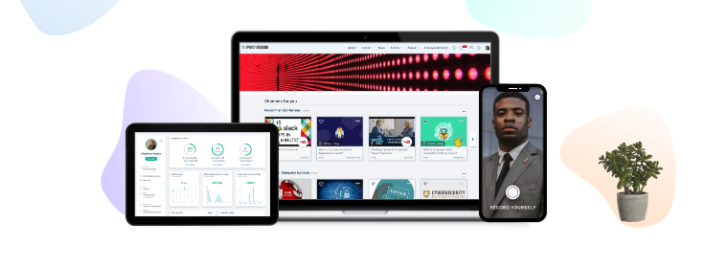The need for employee engagement is even more critical in remote companies. Social learning is a great way for remote organisations to boost engagement, support development, encourage commitment and motivation, and ultimately increase long-term employee retention. Here’s how to get it right.
Why Remote Teams Need Social Learning To Thrive
For some of us, the recent shift to remote work has been fantastic—no more long commutes, no more suit and tie, no more morning rush hour. For others, remote work has been a recipe for loneliness, isolation, disconnection, and disengagement. Buffer’s report on remote work found that while 97% of remote workers like remote work, 20% struggled with loneliness and another 20% missed communicating with teammates[1]. As well as worrying about their employees’ well-being, some business owners are also concerned about a potential drop in innovation and collaboration. Research shows that creativity can drop significantly without face-to-face communication and that we are less likely to collaborate with people if we don’t see their faces[2].
Fortunately, there are steps that businesses can take to keep remote workers engaged and motivated. One of the most effective ways to create a collaborative, supportive environment for remote teams is to implement a social learning platform. This will help transform your organization into a learning community now and prove invaluable even if you decide to return to the office later.
Why Your Business Needs Community Learning
A major survey by Gartner identified a single skill that sets great managers apart. These managers were 3 times more likely to transform their direct reports into top performers. More, their teams were up to 40% more engaged than their counterparts[3].
So, what was this critical skill?
Connection.
The best managers “fostered meaningful connections among employees, teams and the organization to develop an employee’s specific capabilities.” In other words, employees perform better and are more engaged when they are closely connected with their colleagues. We develop best when we work as a collective.
Small wonder then that we are far more inclined to ask a colleague to help us with a work issue than look it up online or take a course. In fact, one study revealed that employees turn to peers for help at work nearly as much as they ask their line managers[4].
Despite our natural inclination toward peer-to-peer learning, few companies have developed formal peer-to-peer learning programs of any sort—a McKinsey survey found that less than half of all businesses promote peer learning[5]. However, when implemented, peer learning can be a powerful engine for performance, engagement, and even retention.
When JetBlue, a US airline, set up a peer learning program coupling employee mentoring with online tuition, the results were impressive: employees felt 85% more engaged, and 96% were more likely to stay with the company[6].
Community learning is a key part of a holistic approach to knowledge management, and a true win-win: employees who are invited to provide peer mentoring feel that their expertise is seen and valued by their employers, and their employers, in turn, get the full benefit of their employees’ knowledge and experience.
Every company could benefit from setting up a community-led peer learning program, but the advantages for remote organizations can be even greater. As well as helping to encourage engagement and retention, peer-to-peer learning encourages a spirit of collaboration, innovation, and mutual support that can be harder to achieve in a remote working environment.

How To Build A Community Learning Program That Works
The great thing about setting up a community learning program is that it doesn’t have to be complicated or expensive. With a few simple steps and the right tools, you can transform your remote L&D set-up.
Encourage Networking With An Internal Employee Directory
For employees to learn from each other, they need to know who to go to when they need help. Otherwise, they’re likely to simply approach their manager or closest colleague. To promote a peer-to-peer support network, transform your employee directory into a kind of “internal LinkedIn.” Ask each employee to flag up particular areas of expertise, then tag these to make them searchable. Suddenly, your remote employees have a network of trainers and coaches at their fingertips.
Make Sure Your NextGen Learning Platform Has In-App Messaging
Allow your employees to connect via messaging when they’re engaging with learning materials. That way, nobody feels like they’re struggling alone. Messaging can be used to ask an expert a question or to seek out coaching or support. Your L&D team can also use messaging to nudge learners or crowdsource ideas or solutions.
Promote Collaborative, Employee-Generated Learning Resources
With a more open and accessible Learner Experience Platform or employee experience platform, learners can create and upload their own resources to help with company-specific challenges or tasks. Even better, encourage your employees to comment and improve on one another’s content to promote community learning.
Self-Record And Share Videos
For remote teams, promoting a sense of community can be as simple as making sure you see one another’s faces more often! Request that employees self-record and share video tutorials or walkthroughs. Their peers will find these more helpful and specific than general training content, and it can also be a great way to create a feeling of connection for remote teams.
Invite Frequent Feedback
Your employees are the best people to tell you whether the learning resources you’ve provided are helpful. Build quick pulse-polls into the learning process to make sure you’re constantly optimizing and adjusting your learning offer to your employees’ needs. Give your employees a voice to make sure they feel like a contributor to your shared learning community.
Host Virtual Hackathons And Cross-Department Challenges
To create a community feeling in remote teams, host online learning events like hackathons or cross-department problem-solving sessions. This will not only create a sense of a shared learning journey, it can also be a great way to cross-pollinate ideas from different branches of the organization and promote innovation.
Community and peer-to-peer learning can increase employee engagement, autonomy, and innovation, but you’ll need the right tools in place to make it happen. A traditional Learning Management System (LMS) is unlikely to be up to the job.
If you haven’t already made the investment in a next-generation learning platform, the switch to remote work may be the ideal moment to upgrade. The need to engage employees is more important than ever when you’re working remotely—and the right social tools are a key component.




